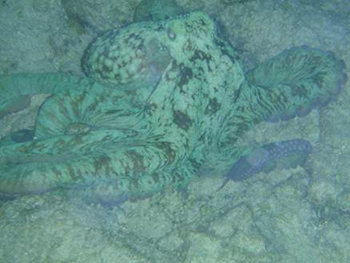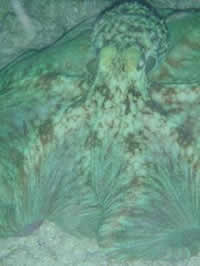Caribbean Reef Octopus
Octopus briareus

Taxonomy
Kingdom Animalia
Phylum Mollusca
Class Cephalopoda
Order Octopoda
Family Octopodidae
Habitat/Range
The Caribbean reef octopus inhabits many reefs and grass beds throughout the western Atlantic, Bahamas, Caribbean, and northern South America. This creature generally does not venture inland towards seas; however, these organisms have been seen in salt water lakes in the Bahamas (Aronson, 1985). This illustrates the variable inhabiting ability these creatures possess. In these habitats, Octopi can be found under certain benthic formations such as rocks, docks, and even sunken structures like ships. These animals can be found at depths between 5 and 30 meters or in the littoral zone of the ocean (Humann, 1992 & Nauen et. al., 1984).
Appearance/Behavior
The Caribbean reef octopus can grow as big as 12 cm with arms as long as 60 cm (Boyle, 1983). These creatures are usually rather bulky in size and blue-green in color, yet, as with all cephalopods, these creatures have a remarkable ability to camouflage themselves via color change. This camouflage ability arises because of special chromatophore cells (Anderson, 2004).
http://www.youtube.com/watch?v=TIpBJqsrRX4
These creatures are generally a top tier predator among coral reefs and other habitats preying mostly on crustaceans and small fish. With this being said, these animals are usually solitary throughout their lives coming together only to mate. Thus, it is not surprising that these animals have been known to act cannibalistically when given the chance especially when males try to court females (Oceana, 1979; Hanlon & Forsythe, 1985). They hide in lairs which give them the ability to ambush their prey and hide from other predators. However, their tactic of ambushing prey means they usually attempt to catch slower moving organisms such as crabs. They also do most of their hunting at night in order to be as stealthy as possible (Boyle, 1983). This is because other, larger predators do feed on them such as grouper or eels (Oceana, 1979). However, these creatures are highly intelligent animals even to the point where many researchers believe them to be the most intellectually prominent invertebrates, the cephalopods. These creatures have the ability to actually learn from their experiences, especially with predators, which gives them the ability to master their habitats (Reef Brief, 2008). This highly structured nervous system has also allowed for the development of extremely complex eyes which extensively help them pin point prey (Cousteau, 1973).
Mating/Lifespan
The Caribbean reef octopus has a very short lifespan, generally only a year to a year and a half. Thus, this creature begins its journey as soon as it hatches, skipping a platonic stage, and within generally three months they are three fourths the size of a mature adult (Oceana, 1979). The male will search the reef during the day for a suitable mate. Once one is found, the male will begin mating by wrapping around the female and then using a special tentacle will attach a sperm packet to the female. The male will die shortly after this moment, but the female will continue to live until the eggs hatch, usually 500 per batch. She will not eat during this time, but she will protect the nest fiercely from all invaders (Oceana, 1979).
Recent Literature
It has been shown and observed for many years that the Caribbean reef octopus, as with other octopi species, use their extremely sensitive eyesight and touch senses to catch prey. However, recent literature has shown that some organisms use sound production to escape from an attacking predator (Bouwma & Herrnkind, 2009). This illustrates how well developed this organism really is, and how it might be using more than just its exquisite sight to find prey. There is also evidence that these creatures will contract certain diseases when living in close quarters with one another. In one study these animals contracted fatal ulcers when grown in the same aquarium versus when grown alone (Hanlon et. al., 1984). This might be a main reason for why these creatures live solitary lives, except to mate, because it is a way to fend against certain diseases.
 Personal Interest
Personal Interest
I chose the Caribbean reef octopus because of the overall intelligence level that the cephalopods as a class posses. Any creature with the intelligence level that these animals possess, warrant sufficient research and review. This can be seen with their ability to speculative hunt where these creatures actually recognize ocean structures that might be used by prey for hiding. The octopus does not know if there is actually prey there, yet the creature will net the hiding spot with its body while searching with its tentacles (Oceana, 1979). It basically goes fishing for food, and I believe only a super intelligent animal would be able to perform this task. However, their ability to camouflage in any environment also caught my attention, as can be seen from the established video. They are just amazing animals that seem to be top tier beasts in any reef system. This is why I feel the Caribbean reef octopus deserved an information page and future research.
Human Safety Concerns
These animals present little danger to humans, and they will generally flee from a location if a human diver gets too close. On this note, these animals will turn blue to warn a threat that they are watching and are worried. You should keep your distance if this act is observed. These animals are also not endangered and present great laboratory specimens for study (Oceana, 1979; Hanlon & Forsythe, 1985).
Literature Cited
Anderson, G. (2004). Marine Ecosystems. Marine Science. 3.1.2.
http://www.marinebio.net/marinescience/03ecology/mlecosystem.htm
Aronson, R.B. (1985). Life History and Den Ecology of Octopus briareus Robson in a Marine Lake. Journal of Experimental Marine Biology and Ecology. 95: 1.
Boyle, P. (1983). Cephalopod Life Cycles Vol. I Species Account. London: Academic Press.
Cousteau, J. (1973). Octopus and Squid: The Soft Intelligence. Garden City, New York: Doubleday & Co.
Hanlon, R.T. & Forsythe, J.W., (1985). Advances in the Laboratory Culture of Octopuses for Biomedical Research. Laboratory Animal Science. 35(1): 33-40.
Hanlon, R.T., Forsythe, J.W., Cooper, K.M., Dinuzzo, A.R., Folse, D.S. & Kelly, M.T. (1984). Fatal Penetrating Skin Ulcers in Laboratory-Reared Octopus. Journal of Invertebrate Pathology. 44:1. 67-83.
Humann, P. (1992). Reef Creature Identification- Florida, Caribbean, Bahamas. New World Publications, Inc., Paramount Miller Graphics, Inc.
Nauen, C., Roper, M., & Sweeny, M. (1984). FAO Species Catalogue. N/A: United Nations Development Program.
Oceana. (1979). Caribbean Reef Octopus: Octopus briareus.
Reef Brief. (2008). Octopuses, The “Brains” of the Sea. Retrieved from http://ambergriscaye.com/reefbriefs/briefs28.html